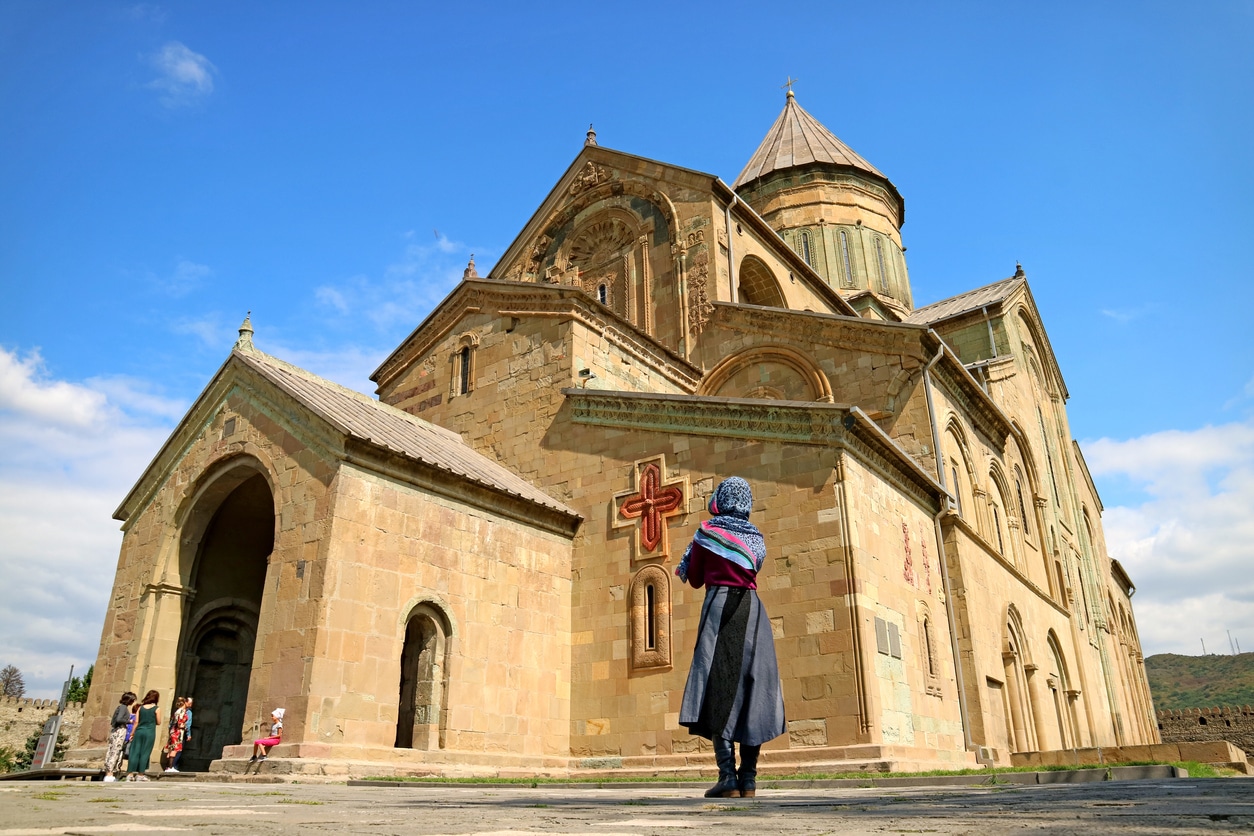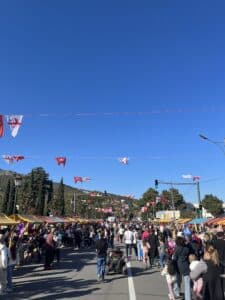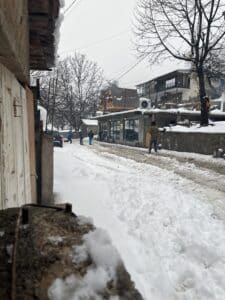Georgia’s three main autumn holidays, Mariamoba, Svetitskhoveli, and Giorgoba, are a great window to experience the soul of the Georgian people. Each of these state holidays represent a different aspect of Georgia’s unique religious tradition which has developed over the last millennia. Celebrations are well attended and important to Georgians. As a way to fully immerse myself in the local culture and tradition, I resolved to attend and observe these holidays while on my study abroad program in Georgia.
My interest in religious holidays stems from both my religious affiliation and personal interests. First, I am a Ukrainian Greek Catholic, meaning that while I am a member of the Catholic Church, my church’s traditions and liturgy resemble those of Eastern Orthodoxy. The Georgian Orthodox Church, the majority religion of Georgia and one of the world’s oldest Christian churches, is a branch of Eastern Orthodoxy. Thus, I was interested in exploring Georgia’s religious heritage to see how it compared with my own.
Second, I enjoy experiencing new cultures and believe that holidays can reflect that which is truly unique and locally valued within a culture. For a full list of Georgia’s major see our Guide to Georgian Holidays on this site.
Mariamoba – August 28
Mariamoba refers to the Dormition of the Virgin Mary (better known in the west as the Assumption). The Dormition refers to the Christian belief that, after the Virgin Mary died, her body was assumed directly into heaven three days later. The Virgin Mary is the most adored woman in Georgian culture due to her immense religious significance as the Mother of God, or Ghvtismshobeli in Georgian.

Mariamoba is primarily a religious and private holiday celebrated at church and at home. The night before the big feast, churches are open all night for a vigil to commemorate the “falling asleep” of the Virgin Mary, and on the morning of the holiday there is Divine Liturgy. On the night of Mariamoba, families typically gather together to have a big feast that marks the end of the two-week Dormition Fast that started on August 14th.
I did not attend an all-night vigil, but I checked out a few churches around Tbilisi during the daytime, and they were filled with people praying or participating in rituals. In Kashueti Church for example, a wedding and a baptism were happening simultaneously among the larger crowd. Mariamoba is a popular day for Georgians to get married due to the patronage of Mary, and since the preceding two-week fasting period is a penitential season where church marriages are not conducted. Across the river, Sameba Cathedral was also busy, with many people coming in to light candles while individual priests led groups in vespers services.

As for the familial aspect of the celebration, I got home late and was surprised to find a large feast laid out for several guests. This was no issue as my host parents immediately sat me down to feed me and introduce me to their family. Toasting began with a special toast to the Virgin Mary and continued with toasts dedicated to good health and family. At the table, I was told about some smaller traditions as well. If your name is Mary (Mariam in Georgian), you get wished a happy name day. In addition, I was told that people with the name Mary get to ride for free at Tbilisi’s Mtatsminda amusement park. Publicly, the special event is not as noticeable as other major holidays and aside from increased church activity, large family gatherings, and irregular working hours, daily life looks the same on the streets of Tbilisi.
If you are staying with a host family and are living in Georgia when Mariamoba occurs, be sure to get home to participate in the holiday and delicious meal.
Svetitskhovloba – October 14
Svetitskhovloba is unique as a religious holiday because it does not celebrate a particular person or event, but a church – the Svetitkhoveli Cathedral in Mtskheta. The cathedral’s name literally translates as the “Cathedral of the Living Pillar.”
The cathedral is one of the most holy places in Georgia for a variety of reasons. Above all is the story of its creation. According to Georgian hagiography, the cathedral marks the location of the robe that Christ was crucified in, brought from Jerusalem to Mtskheta by a Georgian Jew in the first century. It is said that after he gave the robe to his sister, she, overwhelmed with emotion, died. As the robe could not be pried from her hands afterwards, she was buried with it.
Later, St. Nino visited the area in the fourth century. St. Nino is a highly venerated woman in Georgian culture – at age 16, she convinced a Georgian king and queen to convert to Christianity, creating what was then the world’s second Christian state. At the site, she saw that a massive cedar tree had grown at the robe’s burial site. She ordered it to be chopped down and made into seven pillars that would form the basis of the church. However, the seventh pillar began to float in the air before being placed. After a night of prayer St. Nino brought the pillar back down to earth, and the column began to exude a “life-giving liquid” that cured people from diseases. In addition to its importance in Georgian Orthodoxy, the cathedral is also the coronation and burial site of many medieval Georgian monarchs whose graves are still present within the church today.
Svetitskhovloba starts with a Divine Liturgy led by the head of the Georgian Orthodox Church, who is known as a patriarch. When I attended this hugely popular service, it took twenty minutes for everyone to shuffle into the cathedral, and once inside we were greeted by a massive crowd under the magnificent iconography adorning the walls.
A culturally rich street celebration follows the three-hour Divine Liturgy. Next to the Cathedral there are many stands selling souvenirs, street food, and religious items. At the center of town, many roads are closed off to make room for a stage and more vendors. Cultural performances range from traditional Georgian dance and polyphonic singing to guests from other countries (in 2023, the featured show was a Japanese opera singer). Vendor booths featured artisanal goods like wood carvings and baskets, and fresh foods such as honey and churchkhela, a traditional Georgian sweet. As evening came, my friend and I sat next to a ruined fortress on a hill that overlooked Mtskheta, watching the huge crowds celebrating through smoke rising from dozens of outdoor barbecues dotting the outskirts of the town.
During Svetitskhovloba, many visitors also pay visits to local holy sites such as Samtavro Convent. This is where St. Nino is said to have started her ministry and now holds the incorrupt relics of St. Gabriel Urgebadze (1929-1995), the famous holy fool who is the most beloved contemporary Georgian saint. Another popular pilgrimage for this day is to Gelati Monastery, which, among other things, is the burial place of the now-sainted Queen Tamar, who led Georgia through the height of its golden age and who is yet another venerated woman from Georgian history.
Svetitskhovloba is an important Georgian holiday and experiencing its celebration was one of the highlights of my trip abroad.
Giorgoba – November 23
Giorgoba is the feast of St. George, one of the most beloved saints in Georgia. In one hagiographical account, St. George was a Roman soldier born into a wealthy Christian family and known as a brave fighter. When Emperor Diocletian began his persecution against Christians in 303, St. George refused to renounce his faith, and was beheaded after miraculously surviving torture. In Georgia he is often depicted killing a dragon (or Emperor Diocletian), symbolizing the triumph over evil. The roots of Giorgoba in Georgia go back to the fourth century when St. Nino, said to be the cousin of St. George, introduced his veneration while she evangelized the region. Since then, St. George has become the patron and protector of Georgia and his image prevails all over the country. Similar to Mariamoba, Giorgoba is primarily a religious and family holiday featuring a festive church service and large family dinner.
Giorgoba was easily one of my most memorable experiences in Georgia. During the holiday, I was traveling in Mestia- the capital of the mountain region of Svaneti. In the morning, we were greeted by the hostess of our guesthouse who brought us a pile of three Svanetian khachapuri and said that it was traditional to cook khachapuri and give it to guests for the holiday. I and one of my friends went to Divine Liturgy and were warmly greeted by the bishop and laity who gave us another three khachapuri afterwards. It also happened that the first night after we arrived was also the first snow in Mestia, and as such the local youth challenged us to a snowball fight that we promptly won.
As Giorgoba coincided with American Thanksgiving the year I was in Georgia, my friends and I went to look for a restaurant to celebrate. Noticed as travelers, we were invited by an elderly Svan man to come inside his restaurant to celebrate Giorgoba with his extended family. Of course, their children were the same that we battled earlier, but besides this entertaining detail we were warmly received and seated. They treated us to various Svan foods such as kubdari (meat pies) and tashmijabi (a gooey, cheesy mashed potato) while most of the family started to dance lezginkas (a Russian colloquialism denoting traditional Caucasus dances).
Much wine drinking and toasting followed, starting with toasts to St. George (Jgëræg in Svan), the Virgin Mary (Lamaria), and then continuing on with usual Georgian toasts dedicated to friendships and a good life. The old host told us about the greatness of St. George and how in Svan culture, Giorgoba is the most celebrated day of the year with St. George as the most respected saint of the Svans. After a few hours, we ended the night with a hearty “Gaurmarjos!” which is Georgian for “victory,” and is their version of “cheers” and a common parting phrase in Georgian culture. My friends and I went back to our guesthouse, relishing in the hospitality and joyful holiday we got to experience.
Enjoying Local Holidays While Abroad
Before heading abroad with SRAS, check out the holiday guides on this site – which cover all SRAS locations. Mark down the holidays you’ll experience on your calendar and research how you can best witness them. Experiencing Mariamoba, Svetitskhoveli, and Giorgoba made for some of my most cherished memories of Georgia. Local holidays are one of the best ways to fully immerse yourself in local culture and tradition.
You’ll Also Love

Tarkhun: An Incredible, Natural Soda from Georgia
Tarkhun (тархун) is a carbonated soft drink made from tarragon leaves. The drink is known for its typically distinctive green color and is especially popular in Russia and the Caucasus. Tarkhun was first concocted, like most western sodas, by a pharmacist. Mitrofan Lagidze, a Georgian, first mixed carbonated water with his original tarragon syrup in […]

Guide to Food in Adjara
Georgians take pride in their world-renowned culinary achievements. The wide range of dishes offered in Georgian cooking – which include rich, flavorful meat and vegetable based dishes, as well as pastries, dumplings, soups, and unique salads and side dishes means that nearly everyone can find something to love in this cuisine. Food within Georgia itself […]

The Talking Georgian Phrasebook
The Talking Phrasebook Series presents useful phrases and words in side-by-side translation and with audio files specifically geared to help students work on listening skills and pronunciation. Each entry below, divided by category, features an English word or phrase in the left column and its Georgian translation in the right. The Georgian is presented in […]

8,000 Years of Winemaking Lives On in Georgia
Georgia is home to one of the world’s most diverse selections of native grape varieties. Evidence suggests it’s the oldest winemaking region in the world and it retains unique and ancient winemaking technologies to this day. Over millennia, winemaking has become deeply integrated into Georgian cuisine, tradition, and identity. It is present at elaborate feasts […]

Georgian Holidays 2026: A Complete Guide
Georgian holidays strongly reflect the country’s unique traditions and its demographics. First, as more than 80% of Georgians identify with the Georgian Orthodox Church, the strong influence of the church can be felt in the preponderance of Orthodox holidays. Georgia also has several holidays celebrating its statehood and independence, which have been hard-won. We can […]




















